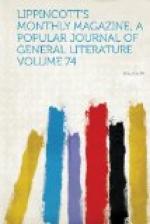“Still farther on the left of Minos, and melting into distance behind him, is seen the shadowy region of Purgatory. Four bright stars—the Cardinal Virtues—give a delicate and cheering light amid the gloom. A group of figures loaded with the burthen of their sins are about to plunge into the lake of purgatorial waters, in the hope of depositing them there. A boat wafted by the wings of an Angel is bearing departed, souls toward Heaven; and near it is a column of pale light to direct its course. In the distance is the mountain that divides Purgatory from Heaven; and Beatrice, the departed mistress of Dante, is standing on its summit, encouraging him to proceed with her to Heaven, where his former guide, Virgil, cannot be admitted (being a Pagan). Groups of Pilgrims who have passed through Purgatory are ascending the mountain. Still farther to the left, and opening in unbroken splendor above the head of Beatrice, is seen the Heaven of Heavens. The golden light pours down on the heads of the Pilgrims, and angels are seen floating in the air and encouraging their efforts. The foreground of this part of the scene presents various objects to cheer the spirit of the Pilgrims in their passage through Purgatory. The entrance indeed is rocky, but shrubs and flowers adorn it, and the Dove, the bird of Hope, is bearing the olive-branch before them.”
If all that was packed into “a room adjoining the Western Museum,” the sight of it must, I think, be admitted to have been a cheap twenty-five cents’ worth. The Cincinnati world of hard upon half a century ago judged it to be so, and flocked to the exhibition in crowds. But very soon the versatile and indefatigable artist devised new means of still further stimulating the curiosity and excitement of his public. A bar ran across the exhibition-room, dividing the space allotted to the spectators from that occupied by the scenery and objects provided for their amusement. But since the available space was, as may easily be imagined, somewhat limited, it came to pass that the foremost spectators, being often of that class of persons who see with the ends of their fingers, would stretch out their arms and audaciously touch “the Black Imp,” or “the Skeleton,” or Minos himself, or any other of the dramatis personae they could reach, to the damage of those somewhat perishable properties. A notice was therefore placarded in the room, written in flame-colored letters and couched in the choicest bugaboo phraseology, warning all such indiscreet persons that the denizens of the Infernal Regions could not be touched by mortal hands with impunity, and that immediate punishment would visit transgressors. Of course it was foreseen that such threats would not avail to restrain, but would rather stimulate the curiosity of the disciples of Saint Thomas. But, sure enough, the threatened punishment, by no means “pede claudo” followed in every case—very accurately with the speed of lightning—on




